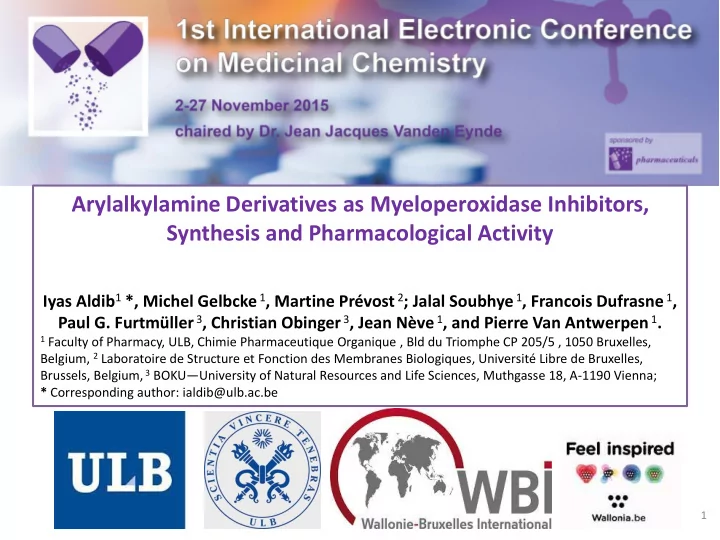

Arylalkylamine Derivatives as Myeloperoxidase Inhibitors, Synthesis and Pharmacological Activity Iyas Aldib 1 *, Michel Gelbcke 1 , Martine Prévost 2 ; Jalal Soubhye 1 , Francois Dufrasne 1 , Paul G. Furtmüller 3 , Christian Obinger 3 , Jean Nève 1 , and Pierre Van Antwerpen 1 . 1 Faculty of Pharmacy, ULB, Chimie Pharmaceutique Organique , Bld du Triomphe CP 205/5 , 1050 Bruxelles, Belgium, 2 Laboratoire de Structure et Fonction des Membranes Biologiques, Université Libre de Bruxelles, Brussels, Belgium, 3 BOKU — University of Natural Resources and Life Sciences, Muthgasse 18, A-1190 Vienna; * Corresponding author: ialdib@ulb.ac.be 1
Arylalkylamine Derivatives as Myeloperoxidase Inhibitors, Synthesis and Pharmacological Activity 2
Abstract: Myeloperoxidase (MPO) is an important target for drug design because of its contributing role in many inflammatory syndromes such as atherosclerosis, rheumatoid arthritis, end-stage renal disease or neurodegeneration. Rational drug design assisted by virtual screening is an interesting tool to design new chemical entities that could inhibit MPO. After a high throughput virtual screening of a database, bis-2,2 ′ -[(dihydro-1,3(2H,4H)-pyrimidinediyl)bis(methylene)]phenol was chosen as a starting hit and we used different strategies of chemical synthesis to perform pharmacomodulation described by the three approaches. This led to 36 compounds that have been assessed in an in vitro inhibition MPO test. We found that the arylalkylamine compounds were active but to a lesser extent than the starting hit. Exception for propylamine derivatives with a phenyl cycle should be noticed. As indolic compounds have demonstrated interesting inhibiting properties, we combined indole ring with the phenolhydropyrimidine structure which led to compounds more active than the hit. Among them, propylamine derivatives were new MPO inhibitors with a nanomolar IC 50 . Kinetics studies for the most potent inhibitors were conducted and reflected a fast reaction with compound I resulting in the accumulation of compound II Structure-activity. Keywords: Myeloperoxidase; Inhibitors; Arylalkylamine 3
Introduction MPO 4
Introduction Myeloperoxidase MPO Neutrophils, monocytes, immune defense system Phagocytosis Kills microorganisms Produces HOCl 5
Introduction MPO is a contributing factor in many inflammatory syndromes such as: Atherosclerosis Multiple sclerosis Atherogenic lesions Rheumatoid arthritis End-stage renal disease Neurodegeneration CVD Parkinson
Finding New MPO inhibitors Pharmaceutical MPO Database HTVS A1 IC 50 = 0.5 µM 7
Results and discussion Pharmacomodulation and docking 8
Results and discussion Docking Validation of docking using poses in HX1, SHA X-ray data HX1 IN PDB 4C1M SHA in PDB 1DNW 9
Pharmacomodulation and docking All compounds were desigend and docked in MPO receptors 1DNW -4C1M Best poses of the docked compounds were compared with X-Ray data of the known inhibitors HX1 and SHA And redocked in same receptors 10
Pharmacomodulation The role of hydroxyl groups on both aromatic cycles A and B The role of bridge length between one nitrogen atom and cycle B after A B removing the hexadrodroperimidine cycle and different The role of aromatic cycle A substitution on both and one atom of nitrogen. cycles A and B. The role of the position of the two nitrogen atoms 11
Pharmacomodulation 12
Designed compounds 3 2 4 5 6 7 8 10 9 13
Designed compounds 14
Some docked poses of the designed compounds in MPO Receptor Glu102 Glu102 Arg239 Phe147 Phe147 Compound 4 Shows hydrogen bonds with Compound 20 Shows hydrogen bonds with Glu102 and Phe147 Arg239 and Glu102 and Phe147 and salt bridge with Glu102 salt bridge with Glu102 Docking results gave some similar interactions as with HX1 and SHA A1 and different free Energy levels - ∆G or affinities with MPO receptors 15
Chemistry 16
Chemistry 17
Chemistry 18
Chemistry 37-38 19
MPO inhibition assay Best synthesized compounds with its IC50 20
Transient-State Kinetics k 3 k 2 21
Mechanism of action Transient-State Kinetics Compound I Compound II Ratio of reduction rate reduction rate compound I rate Compound constant constant to compound II rate (M -1 s -1 ) (M -1 s -1 ) 1.5 × 10 6 4.8 ×10 3 20 313 5.7 × 10 6 1.4 ×10 3 28 4071 1.4 × 10 7 3.5 ×10 3 38 4000 22
Mechanism of action Transient-State Kinetics The kinetic rate constant of reaction of the three best compounds with MPO/compound I /compound II have been measured. 250 Time (s) 200 0,2 4.01 k obs (s -1 ) 8.46 150 9.62 0,15 Absorbance 10.72 100 12.24 14.03 y = 14.378x + 29.649 0,1 50 31.32 R² = 0.9983 0 0,05 0 5 10 15 compound 38 (µM) 0 0,095 250 350 450 550 650 750 Abs at 456 nm 0,085 Wavelength (nm) 0,075 The reaction from compound I to compound II is 0,065 too fast but the reaction with compound II is slow 0,055 leading to the accumulation of compound II 0,00 0,10 0,20 Time (s) 23
Conclusion
Conclusion Pharmacomodulation A1-IC 50 0.5 µM MPO IC 50 n=2 37 with IC 50 0.3-0.05 µM . n=3 38 More active to 2-10 times than the A1 25
Conclusion *best compounds have shown high reduction rate constants of compound I and II and their ratio can explain the accumulation of compound II, illustrating a reversible mechanism of inhibition.. * Arylpropylamine derivatives and adding the indole structure to the original scaffold A1 have given us new effective MPO inhibitors IC 50 = 0.3-0.05 µM 26
Acknowledgments to our team in the Organic Pharmaceutical Chemistry LAB -CPO [Therapeutic Chemistry] – Faculty of Pharmacy-ULB Dr Jalal Soubhye , Dr. Gilles BERGER Ana CERNE , Mélissa CORTESE Dr. Cédric DELPORTE , Damien DUFOUR Caroline NOYON , Florence REYE Prof. François DUFRASNE Prof. Michel GELBCKE Prof. Pierre VAN ANTWERPEN Prof. Jean NEVE 27
Recommend
More recommend